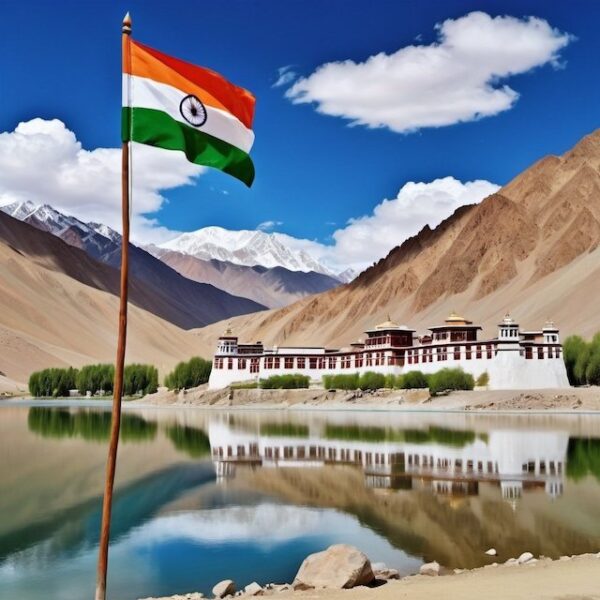In Ladakh, where the heavens touch the land,
A realm of beauty, pure and grand.
Masses rise, their peaks so high,
Kissing the blue, unending sky.
Recently, on 21st January 2023 Sonam Wangchuk, an Indian engineer, environmentalist, and education reformist went on a 21-day hunger strike which he labeled as ‘Climate Fast’ in Ladakh. The aim of this hunger strike was to draw attention of the Indian Government towards the harm caused to the fragile ecology of Ladakh by rapid industrialisation. People of Ladakh have certain demands from the Central Government. These demands include statehood for Ladakh, the inclusion of Ladakh under the sixth schedule leading to the creation of autonomous administrative divisions with certain legislative, judicial, and administrative autonomy, separate Public Service Commission, and two parliamentary seats for the UT. According to them, the only solution to prevent Ladakh from ensuing climate disaster is through its inclusion under the sixth schedule of the Indian Constitution.

The whole issue ignited in August 2019 when Government of India abrogated Article 370 from the state of Jammu and Kashmir and divided it into two Union Territories –J&K and Ladakh. This decision was applauded by the people of Ladakh, however; soon they realized the problems related to it. Now, after becoming the UT, Ladakh did not have any legislature, depriving them of the power to make laws and manage their affairs. Further, earlier Article 370 provided them exclusive rights on the land and jobs, but now after its repudiation, fears of demographic shifts and economic marginalization fueled up in the region.
These fears sparked the debate around the inclusion of Ladakh under the sixth schedule. The demand for autonomy and protection of their rights gained impetus in 2020 when several political, social, and religious groups of Ladakh unified under the People’s Movement for Sixth Schedule for Ladakh. On February 3, both Leh and Kargil observed a total shutdown as thousands of people assembled in the main city after the call by Leh Apex Body and Kargil Democratic Alliance, demanding tribal status under the Sixth Schedule. They based their demands on the fact that in Ladakh, around 97% of residents are the tribal population and classified as ‘Scheduled Tribes‘. Further, The National Commission for Schedules Tribes (“NCST”) also recommended the inclusion of the region of Ladakh under the ambit of the sixth schedule. The report says that the inclusion will help the region in several ways such as the democratic devolution of powers, the preservation and advancement of its unique culture, the protection of land and agrarian rights, and the facilitation of funds for rapid development. It further maintained that “the Ladakh region has several distinct cultural heritages by communities such as Drokpa, Balti, and Changpa, among others, which need to be preserved and promoted”.
Why Sixth Schedule?
Ladakh which is often called as the “Land of High Passes” adorned with towering mountains, valleys, and vast plateaus. Its remarkable scenery is just one aspect of its attractiveness; another is the distinctive fusion of cultures and customs that flourish in this challenging environment. However, now this region is facing immense difficulties. The major concern of the Ladakhi people is the region’s fragile ecosystem. The number of tourists has increased dramatically in the region from a meagre 500 in 1974 to nearly half a million now putting a lot of pressure on the ecosystem. It resulted in consequent flash floods in some of its areas like Gya and Achinathng. It is also suffering from a water crisis owing decrease of 25 % glaciers in the past 60 years. Their fear ensued with the coming of mining companies in the region. Also they fear of losing the pastoral land of the Pashmina herders owing to the Government plan of setting up solar power project in the region.
Another major concern is the unemployment. According to the president of the All Ladakh Unemployment Youth Association (ALUYA), “Ladakh has the highest unemployment rate and the youth are dependent on the government for jobs. We were expecting jobs after becoming a UT. But there is not even one posting on the gazette level”.
Further, the involvement of Bureaucracy in every crucial decision is another issue. After August, 2019 there is a shift of power from Ladakh Autonomous Hill Development Councils (LAHDC) to bureaucrats. Now all the decisions are taken by the bureaucracy alone. People do not have any say in the development projects. Therefore, people desire that priority should be given to the local people of the region as they better know the natural and ecological conditions of the region.

What Ladakh's Inclusion Under Sixth Schedule Means
Including Ladakh under the sixth schedule will lead to the establishment of elected Autonomous Districts and Regional Councils (ADCs and ARCs) in the region. These councils will then have the authority to manage and control the affairs of the tribal population. They can enact laws relating to various crucial domains such as social customs, inheritance, marriage, and divorce and most importantly can manage the forests and farms of the region. Further, the ADCs and ARCs can establish village councils or courts for resolving disputes between the members of the STs. They can also appoint officials to check on the implementation of the laws in the region. The governor will also provide them with the power to try civil and criminal cases in the offenses having the punishment of death with or more than five years of imprisonment. It provides them the authority to build public infrastructure, including roads, marketplaces, and schools, as well as to collect land revenue, impose taxes, control the lending and trading of money, and collect royalties from resource extraction licenses or leases in their regions. However, the applicability of sixth schedule in various states such as Meghalaya has shown some problems associated with it. There are instances of mismanagement of funds meant for development activities by the ADCs. Sometimes, councils misused their autonomous and financial powers such misappropriation of Government funds. These drawbacks can have the significant effect on the economy of the region.
The Central Government owing to the protests in the region is thinking of extending safeguards under Article 370 to Ladakh. Articles 371 and 371-A through J offer “special provisions” for particular states. These special provisions include the power to manage their affairs without any restriction from state and central governments. According to them, the concerns related to the jobs, land and preservation of cultural diversity will be resolved with the same. However, the concern here is Article 371 will fall short of providing extensive autonomy as that of ADCs and ARCs to the local population of Ladakh. Further, the Government is assuring them political representation in the council and ready to provide 80% reservation to the people of Ladakh in public employment.
Navigating Path Ahead
In conclusion, Sonam Wangchuk’s 21-day hunger strike has cast a spotlight on the urgent environmental and administrative challenges facing Ladakh. The region’s fragile ecology, intensified by rapid industrialization and unchecked tourism, is in dire need of protective measures. The demands of the Ladakhi people for statehood, autonomy under the Sixth Schedule, and more substantial political representation reflect deep-seated concerns about cultural preservation, environmental sustainability, and economic stability.
With NDA government in power once again, we hope that the movement started in Ladakh will be a success and government will deliver on its promise that was made in the previous election manifesto. Inclusion under the Sixth Schedule could offer Ladakh a framework for self-governance, allowing local councils to manage resources, safeguard land rights, and uphold cultural traditions. However, the potential for administrative misuse, as seen in other regions with similar autonomy, calls for careful implementation and oversight.
The central government’s consideration of special provisions under Article 371 is a step toward addressing these issues, but may fall short of the comprehensive autonomy needed. As Ladakh navigates these complexities, a balanced approach that integrates environmental conservation with socio-economic development is crucial. The collective voices of Ladakh’s residents, amplified by movements like Wangchuk’s Climate Fast, underscore the necessity for thoughtful, inclusive governance that honors the unique heritage and ecological significance of this extraordinary region.
Lakes like mirrors, so deep and clear,
In their depths, the universe appears.
Barren yet beautiful, serene and bright,
Ladakh, you are a timeless sight.
About the Author
Harshpreet is a law student at Rajiv Gandhi National University of Law, Punjab. Along with pursuing her academic interests, which primarily revolve around Alternate Dispute Resolution and criminal law, she is committed towards innovative and equitable legal practices. She intends to make significant contributions to the society, blending rigorous academic knowledge with practical expertise.











